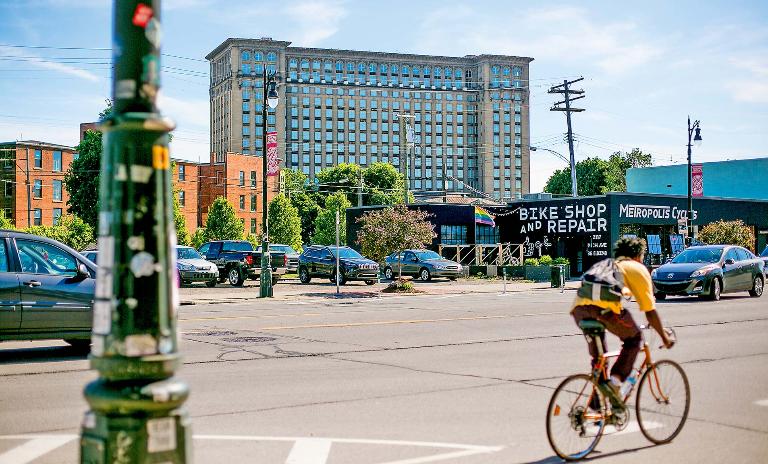On being human
![{[downloads[language].preview]}](https://www.rolandberger.com/publications/publication_image/ta26_human_equation_cover_en_download_preview.jpg)
In this issue of Think:Act magazine we examine in detail what it means to be human in our complex and fast changing world now and in the days to come.



by Bennett Voyles
After 60 years of decline, imaginative leadership is giving Motor City a new spark. Yet the question remains: Will this former jewel of the US economy step up to its former glory or will the hype simply sputter out?
In 1950, Detroit was the wealthiest city per capita in the United States. Its 1.8 million inhabitants were among the luckiest people in a lucky country, beneficiaries of the biggest industry is the US: cars. But it didn't stay that way. As the car industry decentralized so did the city. Detroit shrunk to about 675,000 people and quickly became one of the poorest places in the US. The word "Detroit" evoked images of burnt-out neighborhoods, boarded-up office buildings, out-of-order stoplights and news stories about an $18 billion municipal bankruptcy. Even in 2013, the city still seemed locked in a terminal downward spiral. "Everything was going pretty much to hell in a handbasket," recalls John Austin, director of the Michigan Economic Center and a lecturer on the economy for the University of Michigan.
Today, the lights are finally coming back on in Motor City, literally and figuratively. The city is out of bankruptcy. Most of the traffic lights work and the streetlights are back on at night. Class A office space is now 90% rented out, downtown apartment vacancy rates are near zero and a variety of businesses, large and small, are moving downtown. "There's a lot of optimism here right now," says Harrison West, senior research analyst in Detroit for JLL, the global real estate advisor. "People are excited about what's going on." For decades, people have offered various explanations about what went wrong – the decline of the US automotive industry, white flight, dysfunctional politics – but these days it's a new question: What's going right?
"There's a lot of optimism here right now ... People are excited about what's going on."
Part of the answer is new leadership. Most analysts give high marks to Mayor Mike Duggan, a former prosecutor in suburban Wayne County who positioned himself as a can-do technocrat focused on delivering basic services. He reduced emergency medical response times from 18 minutes to 8, the national average, and police response times for high-priority emergency calls from as much as 58 minutes in 2013 (a claim that is sometimes disputed) to 14.5 minutes. Although some of these gains were accomplished by moving the goal posts, such as redefining what constituted a Priority 1 police call, many of the changes were real. For example, he added new vehicles to the city's fleet and had fire fighters cross-trained as paramedics.
The new leadership does not end with Duggan. A consortium of private philanthropists and local businesses paid $700 million to help reduce the impact of the $18 billion bankruptcy, offsetting some of the cuts made to municipal workers' pensions and preventing the sale of the world-class Detroit Institute of the Arts. All in all, Austin says, it was "pretty amazing to make it all work without selling off more of the crown jewels downtown that the city owned." A new approach to urban planning helped change perceptions of the city. The "Lighter, Quicker, Cheaper" (LQC) philosophy applies a dose of startup thinking to urban spaces. Instead of focusing on major long-term investments, LQC proponents try to create inviting places for people to congregate on the theory that creating a sense of community will drive other opportunities and more investment.

In Detroit, this has meant implementing small-scale experiments to bring desolate corners back to life in cheap and creative ways, such as the urban beach that Southwest Airlines built on a disused lot, summer concerts co-sponsored by local entrepreneur Dan Gilbert, or a mass yoga class, according to the Project for Public Spaces. And the city's new openness to innovation has also led to some rapid improvements in traditional services as well. Police dispatchers now have Uber-style maps to monitor the whereabouts of patrol cars, enabling them to assign calls to specific units.
90% is the minimum estimate of downtown Detroit Class A office space currently rented out.
Internet of things technology is also being used to deliver better service for less money. Miovision, an Ontario, Canada startup, has installed monitors at many of the city's traffic lights, making maintenance much simpler. In the bad old days, when a light went out, it t-ended to stay out. "There was no way for the city to know what was happening," says Lynda Chau, chief marketing officer of Miovision. "Unless you had a concerned citizen who called in, the city would have no way of knowing that part of their traffic network wasn't working." Now, city workers know in advance when a repair needs to be made. And that's only the beginning. Miovision is now using the city as a test bed for what it calls the "World's Smartest Intersection," a package of new technologies that features such innovations as traffic lights that stay yellow a little longer when they sense a cyclist crossing.
Of course, large-scale commercial real estate investing has also played a major role in the city's revival. The exodus of manufacturers from downtown Detroit was a key reason for the city's decline in the 1950s and 1960s. As business left, the tax base shrank, and many people – particularly white people – followed. Some parts of the city became near ghost towns.
Particularly important was local entrepreneur Dan Gilbert's 2010 decision to move his company, Quicken Loans from the suburbs and into downtown. "Once [Gilbert] moved his employees down there, he started gobbling up real estate – vacant office buildings, vacant apartment buildings – for pennies on the dollar. A lot of these buildings are 100-year-old, historic, beautiful buildings; they'd just been neglected," West recalls. Today, the mortgage mogul's real estate firm, Bedrock Detroit, owns over 15 million square feet of apartment and office space in Detroit and Quicken now employs over 17,000 people in the city.
Other companies have followed suit, the latest being Ford Motor Company, which announced its plans to take over Detroit's central train station. "I would say that is the biggest sign of the turnaround that we've had so far," says JLL's West. "That building has been a symbol of the decline of the city for the past 30 years, and to have someone like Ford come in there and renovate it and build a campus there, it's going to completely transform that neighborhood."
Today, Bedrock and other developers are even resorting to new building. "At this point in time, there's really no big blocks of space for a new tenant to come in and occupy it. All the Class A space has been occupied now. And it's not just the behemoths that have returned," according to West. One factor in the decline of Detroit had been the post-war enthusiasm for suburbs. Now the pendulum is swinging back. For many millennials, urban life is the more attractive option, and that shift is pushing employers on the lookout for talent to relocate to big cities, including Detroit.
To an extent, the gambit seems to be working. The population is still declining, as it has been since the 1950s, but the rate of decline is lower than it's been in decades, just 3,541 in 2016, and the city is gaining many new, highly skilled residents: At 78%, Detroit had the fastest growth in numbers of college-educated millennials of any city in the US between 2010 and 2015, according to a 2017 study published in Forbes by Pete Saunders, a Chicago-based urban planning consultant. "There is a real interest and kind of a market for Detroit as an urban place to develop and a kind of cool and interesting, Berlin-like place to be," says Austin – and it's a trend he expects to see continue. "You will see a kind of continued colonization outward of neighborhoods and new conversion developments and business and commercial and entertainment districts expanding."

But there's a lot of work ahead. The crime rate is declining about 5% a year, but it's still well above most US cities. Over 5,800 vacant homes have been torn down, but as many as 29% of the city's structures are falling apart and still need to be repaired or razed, according to an estimate by the Skillman Foundation, a local advocacy group. There is also no consensus yet about what to do with the wide open spaces that remain once the houses are razed, and some analysts say the economy remains too dependent on the automotive industry – especially at a time when the future of cars is uncertain. The resistance of the white suburbs towards building a metro area-wide transportation system has also slowed development, according to Austin. "We're the one major metro in the country that doesn't have a regional transportation system that is integrated and has public transportation that works," he says.
"There is a real interest and kind of a market for Detroit as an urban place to develop."
The biggest difficulty, however, may be the persistence of the city's historically sharp racial divide and many long-time residents in the largely African-American city feel the recovery has not yet arrived for them. "When you see all these hipsters and techies and white college kids, white young people, running around and living in lofts downtown, they're like, 'What's up with that? Where's my Detroit? How is this working for me?'" Austin says. That's a problem not only for the long-term residents, but also for the city, since their resentment discourages newcomers. Many immigrants from other countries who come to Michigan continue to shun the still largely African-American city.
Detroit mystery writer Elmore Leonard once noted that "[t]here are cities that get by on their good looks, offer climate and scenery, views of mountains or oceans, rockbound or with palm trees. And there are cities like Detroit that have to work for a living." For the next few years, at least, Detroit and its boosters still have their work cut out for them. The good news is that they're finally getting somewhere.


![{[downloads[language].preview]}](https://www.rolandberger.com/publications/publication_image/ta26_human_equation_cover_en_download_preview.jpg)
In this issue of Think:Act magazine we examine in detail what it means to be human in our complex and fast changing world now and in the days to come.
Curious about the contents of our newest Think:Act magazine? Receive your very own copy by signing up now! Subscribe here to receive our Think:Act magazine and the latest news from Roland Berger.
